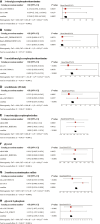Identifying serum metabolite biomarkers for autoimmune diseases: a two-sample mendelian randomization and meta-analysis
- PMID: 38686387
- PMCID: PMC11056515
- DOI: 10.3389/fimmu.2024.1300457
Identifying serum metabolite biomarkers for autoimmune diseases: a two-sample mendelian randomization and meta-analysis
Abstract
Background: Extensive evidence suggests a link between alterations in serum metabolite composition and various autoimmune diseases (ADs). Nevertheless, the causal relationship underlying these correlations and their potential utility as dependable biomarkers for early AD detection remain uncertain.
Objective: The objective of this study was to employ a two-sample Mendelian randomization (MR) approach to ascertain the causal relationship between serum metabolites and ADs. Additionally, a meta-analysis incorporating data from diverse samples was conducted to enhance the validation of this causal effect.
Materials and methods: A two-sample MR analysis was performed to investigate the association between 486 human serum metabolites and six prevalent autoimmune diseases: systemic lupus erythematosus (SLE), rheumatoid arthritis (RA), inflammatory bowel disease (IBD), dermatomyositis (DM), type 1 diabetes (T1D), and celiac disease (CeD). The inverse variance weighted (IVW) model was employed as the primary analytical technique for the two-sample MR analysis, aiming to identify blood metabolites linked with autoimmune diseases. Independent outcome samples were utilized for further validation of significant blood metabolites. Additional sensitivity analyses, including heterogeneity test, horizontal pleiotropy test, and retention rate analysis, were conducted. The results from these analyses were subsequently meta-integrated. Finally, metabolic pathway analysis was performed using the KEGG and Small Molecule Pathway Databases (SMPD).
Results: Following the discovery and replication phases, eight metabolites were identified as causally associated with various autoimmune diseases, encompassing five lipid metabolism types: 1-oleoylglycerophosphoethanolamine, 1-arachidonoylglycerophosphoethanolamine, 1-myristoylglycerophosphocholine, arachidonate (20:4 n6), and glycerol. The meta-analysis indicated that three out of these eight metabolites exhibited a protective effect, while the remaining five were designated as pathogenic factors. The robustness of these associations was further confirmed through sensitivity analysis. Moreover, an investigation into metabolic pathways revealed a significant correlation between galactose metabolism and autoimmune diseases.
Conclusion: This study revealed a causal relationship between lipid metabolites and ADs, providing novel insights into the mechanism of AD development mediated by serum metabolites and possible biomarkers for early diagnosis.
Keywords: Mendelian randomization; autoimmune diseases; biomarkers; meta-analysis; serum metabolites.
Copyright © 2024 Wang, Huang, Ge, Feng, Zhang, Li and Wang.
Conflict of interest statement
The authors declare that the research was conducted in the absence of any commercial or financial relationships that could be construed as a potential conflict of interest.
Figures





Similar articles
-
Causal association between plasma metabolites and diverse autoimmune diseases: a two-sample bidirectional mendelian randomization study.Front Immunol. 2024 Nov 7;15:1437688. doi: 10.3389/fimmu.2024.1437688. eCollection 2024. Front Immunol. 2024. PMID: 39575250 Free PMC article.
-
Causal Relationship Between Gut Microbiota and Autoimmune Diseases: A Two-Sample Mendelian Randomization Study.Front Immunol. 2022 Jan 24;12:746998. doi: 10.3389/fimmu.2021.746998. eCollection 2021. Front Immunol. 2022. PMID: 35140703 Free PMC article.
-
Non-targeted metabolomics revealed novel links between serum metabolites and primary ovarian insufficiency: a Mendelian randomization study.Front Endocrinol (Lausanne). 2024 Apr 26;15:1307944. doi: 10.3389/fendo.2024.1307944. eCollection 2024. Front Endocrinol (Lausanne). 2024. PMID: 38737546 Free PMC article.
-
Association between Omega-3 fatty acids and autoimmune disease: Evidence from the umbrella review and Mendelian randomization analysis.Autoimmun Rev. 2024 Nov;23(11):103651. doi: 10.1016/j.autrev.2024.103651. Epub 2024 Sep 30. Autoimmun Rev. 2024. PMID: 39357585 Review.
-
Mendelian randomization studies of risk and protective factors for osteoporosis: a systematic review and meta-analysis.Front Endocrinol (Lausanne). 2025 Jan 16;15:1486188. doi: 10.3389/fendo.2024.1486188. eCollection 2024. Front Endocrinol (Lausanne). 2025. PMID: 39886030 Free PMC article.
Cited by
-
Investigation of causal associations between cerebral cortical structure and Barrett's esophagus: insights from Mendelian randomization and meta-analysis.J Thorac Dis. 2024 Dec 31;16(12):8582-8601. doi: 10.21037/jtd-24-698. Epub 2024 Dec 16. J Thorac Dis. 2024. PMID: 39831248 Free PMC article.
-
Causal relationships between metabolic syndrome, plasma metabolites, and female reproductive diseases: insights from a two-step mendelian randomization approach.Nutr Metab (Lond). 2025 Jun 13;22(1):60. doi: 10.1186/s12986-025-00955-8. Nutr Metab (Lond). 2025. PMID: 40514674 Free PMC article.
-
Genetic Insights Into Dietary Factors, Metabolic Traits and Myasthenia Gravis Risk: A Large-Scale Two-Sample Mendelian Randomization Study in European Populations.Food Sci Nutr. 2025 May 26;13(6):e70236. doi: 10.1002/fsn3.70236. eCollection 2025 Jun. Food Sci Nutr. 2025. PMID: 40444113 Free PMC article.
References
Publication types
MeSH terms
Substances
LinkOut - more resources
Full Text Sources
Medical

